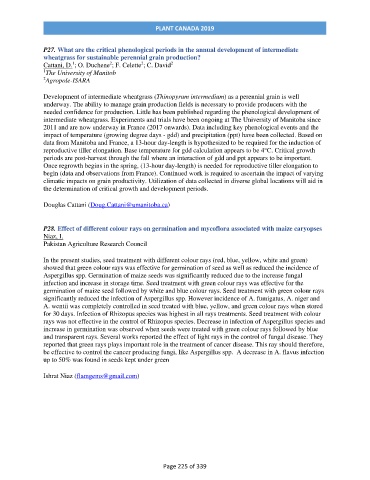Page 227 - PC2019 Program & Proceedings
P. 227
PLANT CANADA 2019
P27. What are the critical phenological periods in the annual development of intermediate
wheatgrass for sustainable perennial grain production?
2
1
2
Cattani, D. ; O. Duchene ; F. Celette ; C. David 2
1 The University of Manitob
2 Agropole-ISARA
Development of intermediate wheatgrass (Thinopyrum intermedium) as a perennial grain is well
underway. The ability to manage grain production fields is necessary to provide producers with the
needed confidence for production. Little has been published regarding the phenological development of
intermediate wheatgrass. Experiments and trials have been ongoing at The University of Manitoba since
2011 and are now underway in France (2017 onwards). Data including key phenological events and the
impact of temperature (growing degree days - gdd) and precipitation (ppt) have been collected. Based on
data from Manitoba and France, a 13-hour day-length is hypothesized to be required for the induction of
reproductive tiller elongation. Base temperature for gdd calculation appears to be 4°C. Critical growth
periods are post-harvest through the fall where an interaction of gdd and ppt appears to be important.
Once regrowth begins in the spring, (13-hour day-length) is needed for reproductive tiller elongation to
begin (data and observations from France). Continued work is required to ascertain the impact of varying
climatic impacts on grain productivity. Utilization of data collected in diverse global locations will aid in
the determination of critical growth and development periods.
Douglas Cattani (Doug.Cattani@umanitoba.ca)
P28. Effect of different colour rays on germination and mycoflora associated with maize caryopses
Niaz, I.
Pakistan Agriculture Research Council
In the present studies, seed treatment with different colour rays (red, blue, yellow, white and green)
showed that green colour rays was effective for germination of seed as well as reduced the incidence of
Aspergillus spp. Germination of maize seeds was significantly reduced due to the increase fungal
infection and increase in storage time. Seed treatment with green colour rays was effective for the
germination of maize seed followed by white and blue colour rays. Seed treatment with green colour rays
significantly reduced the infection of Aspergillus spp. However incidence of A. fumigatus, A. niger and
A. wentii was completely controlled in seed treated with blue, yellow, and green colour rays when stored
for 30 days. Infection of Rhizopus species was highest in all rays treatments. Seed treatment with colour
rays was not effective in the control of Rhizopus species. Decrease in infection of Aspergillus species and
increase in germination was observed when seeds were treated with green colour rays followed by blue
and transparent rays. Several works reported the effect of light rays in the control of fungal disease. They
reported that green rays plays important role in the treatment of cancer disease. This ray should therefore,
be effective to control the cancer producing fungi, like Aspergillus spp. A decrease in A. flavus infection
up to 50% was found in seeds kept under green
Ishrat Niaz (flamgems@gmail.com)
Page 225 of 339

